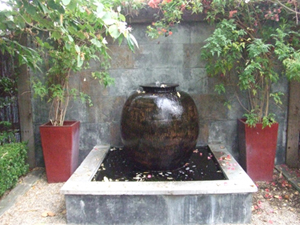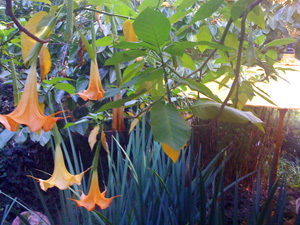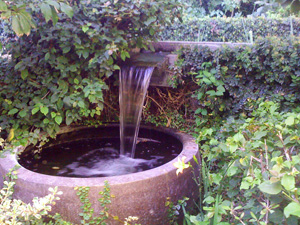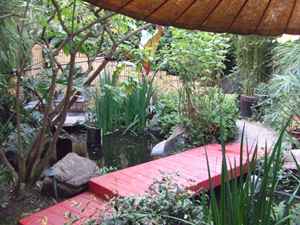A Secret Garden
- Details
- Category: Spiritual Community
- Published on Friday, 03 January 2014 15:18
- Written by Renee Montgomery
Hidden on Adams Blvd. is a serene garden where one can rest and recharge in nature. Developed by the Movement of Spiritual Inner Awareness (MSIA, or Peace Labyrinth, as it is more commonly known) on the site of the former Guasti historic mansion, the Meditation Garden is open to the public and offers a cornucopia of enchanting landscaping ideas for local residents.
 In a walk through of the nearly six acre garden, Carol Jones, MSIA’s Administrative and Garden co-ordinator, pointed out key design principles of Asian landscaping that can be easily adapted by local residents on a smaller scale. TNN readers may not be blessed with an impressive three-tiered property like the MSIA, but they can effectively implement any aspect of this enchanting garden.
In a walk through of the nearly six acre garden, Carol Jones, MSIA’s Administrative and Garden co-ordinator, pointed out key design principles of Asian landscaping that can be easily adapted by local residents on a smaller scale. TNN readers may not be blessed with an impressive three-tiered property like the MSIA, but they can effectively implement any aspect of this enchanting garden.Central to the Meditation Garden’s design is the Asian principle of ch’i and the art of channeling the natural flow of energy, life force or being. This may sound ‘new age-y,’ but after Jones pointed out several simple ways this concept is manifested in the Meditation Garden, it is clear that respect for the essence of natural materials and the coordination of natural lines is the foundation for successful landscape design.
 First, ch’i means working with what you have, preserving the best of the yard you inherited. For instance, three avocado trees from the original Guasti orchard were preserved in the Meditation Garden design -- with the trees’ graceful shapes creating the asymmetrical lines and shade characteristic of Asian gardens. Rather than cover the neighbor’s block wall, the Meditation Garden designer worked it into the design by picking up the wall color in the outdoor furniture upholstery, creating the appearance that the block wall was an intentional part of the design. Jones pointed out how the neighbor’s skyline was integrated too – it’s not going away so be sure to take it into account in developing your own garden’s vista. Embrace, don’t fight or try to ignore.
First, ch’i means working with what you have, preserving the best of the yard you inherited. For instance, three avocado trees from the original Guasti orchard were preserved in the Meditation Garden design -- with the trees’ graceful shapes creating the asymmetrical lines and shade characteristic of Asian gardens. Rather than cover the neighbor’s block wall, the Meditation Garden designer worked it into the design by picking up the wall color in the outdoor furniture upholstery, creating the appearance that the block wall was an intentional part of the design. Jones pointed out how the neighbor’s skyline was integrated too – it’s not going away so be sure to take it into account in developing your own garden’s vista. Embrace, don’t fight or try to ignore. Secondly, respecting the ch’i life force in landscaping is illustrated in the Meditation Garden by emphasizing the inherent properties of natural materials. Don’t use plants unsuited to the climate or in ways nature never intended, and consider the change of season and how plants will mature.
Secondly, respecting the ch’i life force in landscaping is illustrated in the Meditation Garden by emphasizing the inherent properties of natural materials. Don’t use plants unsuited to the climate or in ways nature never intended, and consider the change of season and how plants will mature. The Meditation Garden also integrates drought-tolerant succulents, which provide novel shapes and eye-catching detail. Layering contrasting textures – like yin and yang – also serves to highlight each plant’s unique effect. The sound of running water can be heard in every corner of the Meditation Garden but, Jones counsels, be prepared for maintenance. Instead of a fountain, consider interesting-shaped pieces of wood, stones or shells as garden centerpieces – a great idea for residents on a budget. Worn from wind or water, such artifacts are highly prized in Asian culture for their timelessness.
Finally, Asian gardens are places to sit and reflect, so incorporate seating. On the day of our walk through, a therapist worked with a patient on a secluded bench - finding the peaceful environment conducive to soul-searching. Simple stones or boards are a natural alternative to store-bought benches.

Visit the Meditation Garden, see these Asian principles in effect, and see how an individual corner can be easily translated into your own yard. Historic and garden tours are available every Sunday from 12-4 pm with additional visiting hours Tuesday-Friday, 11 am -3 pm. The garden is closed holidays, Mondays and Saturdays unless attending scheduled events.
3500 West Adams Blvd. 323-737-4055
